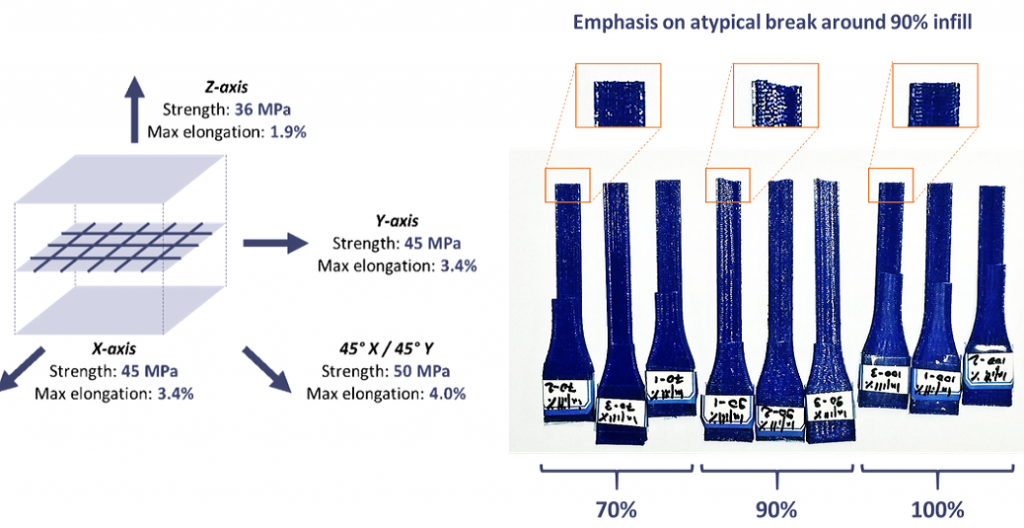

As 3D printing continues to thrive and progress as a technology, innovators and makers seem to be on an infinite path for changing the world and manufacturing as we know it, with incredible new designs. Along with this comes what almost seems to be an infinite number of new 3D printer and filament manufacturers along with a wide array of peripheral products, educational materials, and everything we could hope to choose from to fulfill our 3D printing needs.
With the foundation set and so many tools at our fingertips, many are beginning to take a harder look quite simply now at how we can become better at 3D printing itself. This is a complicated subject, however, with so many different techniques and choices regarding 3D printing and settings. 3DMatter used a MakerBot Replicator (employing FDM) and PLA material to do some specialized research into the effects of:
- Infill percentage
- Layer height
- Infill pattern
3DMatter endeavored to see how the following influenced a print:
- Maximum stress
- Elongation at break
- Rigidity (Young Modulus)
- Yield stress
Finding that most users are focusing on and looking for either high quality level or less financial investment, or both, they geared the study around the questions that those agendas bring forth. With all of these focuses, what the researchers found, broadly, was that:
- With a 90% infill, elongation is at its lowest, and would seem to be something users would want to consider.
- Quality and layer height seem to go hand in hand, and quality deteriorates as layer height is increased.
- Linear (tilted 45°) and diagonal infill patterns yield the best results, with the caveat that only exposed decorative designs should be used—and then only when they are integral to design.
Regarding anisotropy, which relates to directional dependence, findings showed that issues definitely tend to arise on the Z-axis at a rate of 20-30%, with half that rate also resulting in elongation breakage. The interface between layers is weaker, and thus responsible for complications.

When it came to the study of infill percentages, the researchers did have some surprises. They found that ‘evolution of [specimen strength] is not linear: the strength gained per percentage point of infill also increases.’ With more infill obviously comes the need for more material and more time for 3D printing, which does have consequences on strength as well.
The greatest surprise though, according to 3DMatters research, was that elongation at break remained consistently at 2.8%, until 90% infill, where it dropped to 2.0%. The theory behind this is that with the much higher infill, ‘faults’ are created due to the lack of gaps in the mesh. Small ‘air voids’ cause strain, and thus, breakage, which seems specific to the 90% infill rate, yet with ‘lower elongation at breakage.’ At 100% there are no more voids and all of the filaments are touching. The yield stress test revealed the same results, thus validating the information on lower elongation breakage at 90% infill.
Regarding rigidity, they used a non-adjusted curve to test this, which suggested that there is a positive relationship between infill percentage and rigidity, but if they were to use a more adjusted curve, it would be in the same range as rigidity for PLA.
This research is good, broad information for anyone trying to weigh out the positives and negatives that could be caused by particular settings. There are other items that could be included in a more advanced research study to include different materials other than just PLA, as well as different temperatures and speeds. Other 3D printers could be included in for more advanced testing purposes as well.
Does this information support findings you have seen while 3D printing your own items? Will this change how you choose settings in the future? Tell us your thoughts in the Researching Infill forum over at 3DPB.com.
[source: 3DMatter ]
If you're looking to get architectural 3D animation in the USA, our service provides an exceptional way to bring your architectural concepts to life through dynamic, immersive visuals. Through our platform, you can easily request high-quality 3D animations that showcase your designs in motion, offering a detailed view of your project from multiple angles and perspectives. Whether it's for a real estate development, a commercial building, or an urban planning project, our expert team ensures that every detail is captured in a visually compelling animation.
Through our website, you can seamlessly get architectural 3D animation tailored to your project’s specific needs. With our help, you can offer potential clients or investors an engaging experience that goes beyond static images. By integrating CGI animations with real-world settings, lighting, and textures, our team creates a lifelike experience that allows your audience to interact with your project as though it were already built. This service is perfect for presenting complex designs in a clear, visually attractive way that stands out in the competitive architectural market.




